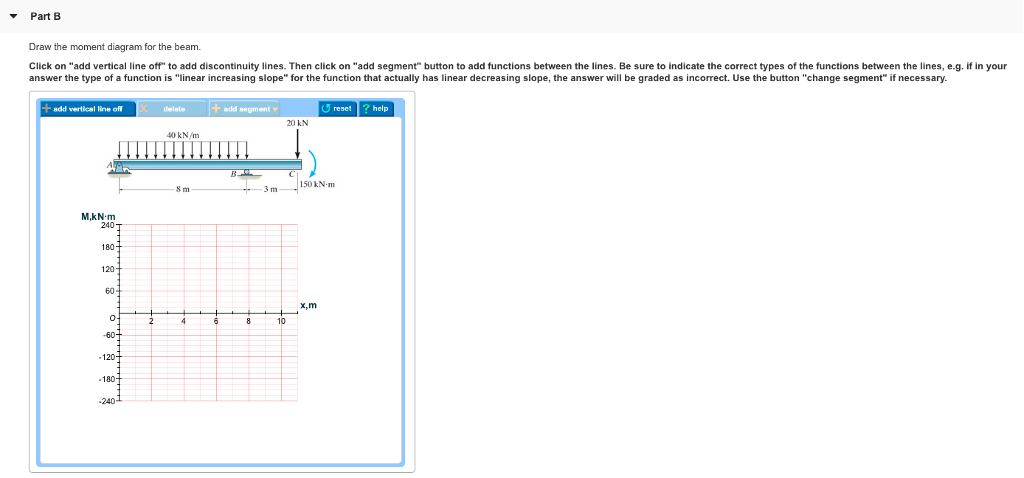41 draw the shear diagram for the beam. 7.55
also draw-bridge, "bridge which may be drawn up or let down," c. 1300, drawebrigge, from draw (v.) + bridge (n.).
"susceptible of contraction," 1706, from French contractile, from Latin contract-, past participle stem of contrahere "to draw several objects together; draw in, shorten," from assimilated form of com "with, together" (see con-) + trahere "to draw" (see tract (n.1)). Related: Contractility.
early 15c., retreten, "to draw in, draw back, leave the extremities," also "to fall back from battle;" from retreat (n.) and in part from Old French retret, retrait, past participle of retrere "to draw back." Related: Retreated; retreating.

Draw the shear diagram for the beam. 7.55
early 15c., "draw (objects or persons) to oneself," also a medical term for the body's tendency to absorb fluids, nourishment, etc., or for a poultice treatment to "draw out" diseased matter; from Latin attractus, past participle of attrahere "to draw, pull; to attract," from assimilated form of ad "to" (see ad-) + trahere "to pull, draw" (see tract (n.1)). Of physical forces (magnets, etc.), from 17c. Figurative sense of "be attractive, draw to oneself the eyes or attentions of others" is from 1690s. Related: Attracted; attracting.
early 15c., retracten, "to draw (something) back, draw in, absorb," from Old French retracter (14c.) and directly from Latin retractus, past participle of retrahere "to draw back" (see retraction). Sense of "to revoke, recant, take back" (an offer, declaration, etc.), is attested from 1540s, probably a back-formation from retraction. Of body parts, etc., "draw or shrink back, draw in," 1660s. Related: Retracted; retracting.
c. 1400, overdrauen, "to draw (something) across," from over- + draw (v.). The banking sense of "to draw upon for a sum beyond one's credit" is from 1734. Related: Overdrawn; overdrawing.
Draw the shear diagram for the beam. 7.55.
mid-13c., portraien, "to draw, paint" (something), from Anglo-French purtraire, Old French portraire "to draw, to paint, portray" (12c.), literally "trace, draw forth," from por- "forth" (from Latin pro-; see pro-) + traire "trace, draw," from Latin trahere "to drag, draw" (see tract (n.1)). Meaning "depict in words, describe" is from late 14c. Related: Portrayed; portrayer; portraying. Latin protrahere was "to draw forth" but in Medieval Latin also "to draw, paint."
string, cord, lace, or rope used to "draw" (gather, or shorten) fabric or other material by 1831, from draw (v.) + string (n.). Also draw-cord (1840); drawing-string (1784).
Acorn Brooks Stair lift s · 0019. Acorn 180 user manual · OLYMPUS DIGITAL CAMERA. Acorn Brooks 120/130 Footrest Spring · 0018. Acorn...
"give motion to by the act of pulling," c. 1200, drauen, spelling alteration of Old English dragan "to drag, to draw, protract" (class VI strong verb; past tense drog, past participle dragen), from Proto-Germanic *draganan "to draw, pull" (source also of Old Norse draga "to draw, drag, pull," Old Saxon dragan "to carry," Old Frisian drega, draga, Middle Dutch draghen "to carry, bring, throw," Old High German tragan "carry, bring, lead," German tragen "to carry, bear"), from PIE root *dhregh- (see drag (v.)). Sense of "make a line or figure" (by "drawing" a pencil across paper) is from c. 1200. Meaning "remove or extract (a weapon) by pulling" is from late 12c., originally of a sword. Sense of "to pull (a bowstring)" is from c. 1200. To draw a criminal (drag him at the tail of a horse to the place of execution) is from c. 1300. Meaning "select one (from a number of lots, etc.)" is from c. 1300. Sense of "bring (a crowd, an audience, etc.) by inducement or attraction" is from 1580s. Of a ship or boat, "to displ
From a recent LinkedIn discussion it became evident that the adoption of Named Ranges for referencing data (although reasonably well known) is far from.
c. 1400, "act of pulling," from draw (v.). Meaning "game or contest that ends without a winner," is attested first in drawn match (1610s), but the signification is uncertain origin; some speculate it is from withdraw. Hence, as a verb, "to leave (a game, etc.) undecided," from 1837. Colloquial sense of "anything that can draw a crowd" is from 1881 (from the verb in the related sense).


0 Response to "41 draw the shear diagram for the beam. 7.55"
Post a Comment